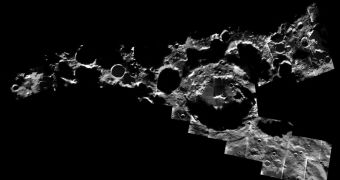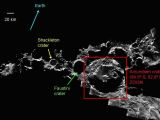It might not look the ideal place to be in, but NASA and the ESA are currently exploring the possibility to put a permanent lunar base in the south polar regions of the Moon. Due to the unique axis tilt in relation to the position of the Sun, the south pole of the Moon is mostly kept in darkness throughout the year, leaving only a few portion of the surface untouched by the shadows. During the span of a full year, ESA's SMART-1 probe had the mission to fully map the south pole of the Moon, in case such a documentation might be needed for future manned lunar exploration missions.
The instrument responsible for collecting the images, SMART-1's Advanced Moon Imaging Experiment, studied different levels of solar illumination of the Moon's surface in the south pole over the changing seasons, with the greatest resolution yet.
The Moon's south pole is located in the rim of Shacketon crater in the biggest basin known to us, basin Aitken, measuring 2600 kilometers in diameter. Not only did SMART-1 show that a permanent lunar base in Shackleton crater is viable, but it also revealed increased geological interest right in the vicinity of the south pole. By measuring the solar illumination conditions over the period of a full year, SMART-1 was able to determine that about 100 kilometers away from the south pole, 10 kilometers from the Shackleton crater rim, lies a ridge permanently illuminated, an ideal location for a possible lunar base.
Also, the southern areas seem to present much more craters than other locations on the surface of the Moon, meaning that the terrain is ancient. Features such as Amundsen crater, measuring 105 kilometers in diameter, lye as close as 100 kilometer to the south pole.
Further still, there is evidence that hydrogen gas may be emerging from the surface of the regions near the south pole, but whether this precious element is originating from water ice deposits under the surface hasn't been confirmed yet. SMART-1 Project Scientist Bernard Foing says that in order to determine if indeed water ice can be found on the Moon, one must first know how the volatile elements were delivered to the surface by various cosmic bodies and if they could have been preserved intact over time to accumulate in greater reserves.
NASA researchers reveal that the south polar regions of the Moon could possibly have twice the number of craters than the designated landing spot selected for the Apollo 15 landing site, by measuring the material ejected by the various impacts in the vicinity of Shackleton, and estimate that the crater itself could be more than 3.9 million years old, contesting the previous studies which estimate it to be much younger than that.
If until now the south pole had relative low chances of being chosen as the location for a future lunar base, now it looks that the odds are ever increasing. Principal Investigator for the AMIE, Jean-Luc Jesset, says that the south pole is now one the most exciting spots on the Moon's surface for future exploration, for both manned and unmanned missions.

 14 DAY TRIAL //
14 DAY TRIAL // 
